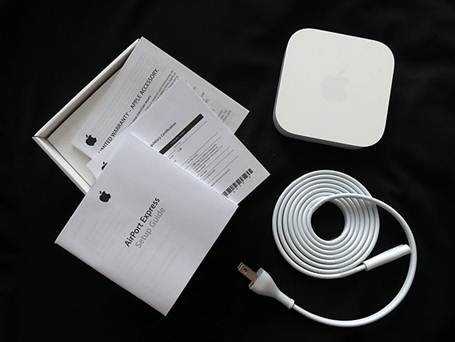Small but powerful Wi-Fi base station
Ratings: 4.5/5
Price: $119
www.apple.com

The
Express uses the same configuration tools and options as its bigger siblings,
the Extreme and Time Capsule
The redesigned 2012 model of the AirPort
Express Wi-Fi base station has become the mouse that roars. The revisions
transform this model into a tiny powerhouse by adding to its previous modest
attributes a second Ethernet port, simultaneous dual-band Wi-Fi and a guest
network option all in a form factor identical to the Apple TV (expect white and
a bit lighter).
At the same $119 as the previous two
models, the AirPort Express might serve an entire apartment or single-floor
home or act as a main base station to which other base stations are chained via
Wi-Fi or Ethernet, where previously the $199 AirPort Extreme base station would
be required.
The Express uses the same configuration
tools and options as its bigger siblings, the Extreme and Time Capsule. In
testing, performance and throughput were in line with those models.
While the previous AirPort Express (2008)
supported 802.11n networking, you had to make a choice to set the Express to
use either the 2.4GHz or 5GHz band available for 802.11n, not both at the same
time (known as simultaneous dual-band).
Having both bands available at once in the
2012 AirPort Express (a feature added in 2009 to the Extreme and Time Capsule
models) allows your network to perform at the highest possible speeds no matter
how distant a device is from the base station while it remains in range of a
signal.
The new second Ethernet port opens up the
Express by allowing both a Wide Area Network (WAN) connection to a broadband
modem or a larger network and a Local Area Network (LAN) connection to computer
via Ethernet or to an Ethernet switch to which many computers and devices can
be connected.

The Time Capsule and Extreme each have a
built-in three-port Gigabit Ethernet (10/100/1000Mbps) switch, while the
Express continues to use 10/100 Mbps Ethernet on both its WAN and LAN ports.
However, the 100 Mbps limit doesn’t affect data exchanges between Wi-Fi
devices, which work at the maximum wireless rates available and it’s easy
enough to plug in an inexpensive Gigabit Ethernet switch to allow the fastest
throughput between wired devices.
Guest networking has also been added to the
Express, which allows a second virtual network with a unique network name
(SSID) and security scheme to be available to visitors or others without
providing access to the main network.
Apple also brings over the option from the
other simultaneous dual-band gateways of naming the 2.4GHz and 5GHz networks
separately.
The Express continues to have a unique
option in the Wi-Fi base station line-up, which is a dual-function analogue and
digital optical (Toslink) port which lets it be a target for AirPlay audio
streaming form iTunes on a Mac or Windows system and from any capable app in
iOS.
The 2012 Express, just like the two
preceding models, can only share a single USB printer using Bonjour. The
Extreme and Time Capsule use Bonjour sharing for a printer or hard drive (via
AFP and Samba) through a USB port, but also allow the use of a USB hub to share
multiple devices.
Buying advice. The quibbles about USB and Ethernet are relatively minor compared
to the features available in this mighty mite. For the money, the Express makes
an effective base station for modestly sized apartments or homes or where
access is only needed in a few adjacent rooms in an office. This sleek model is
the right choice for many and, at $80 less than the AirPort Extreme, a prudent
one as well.